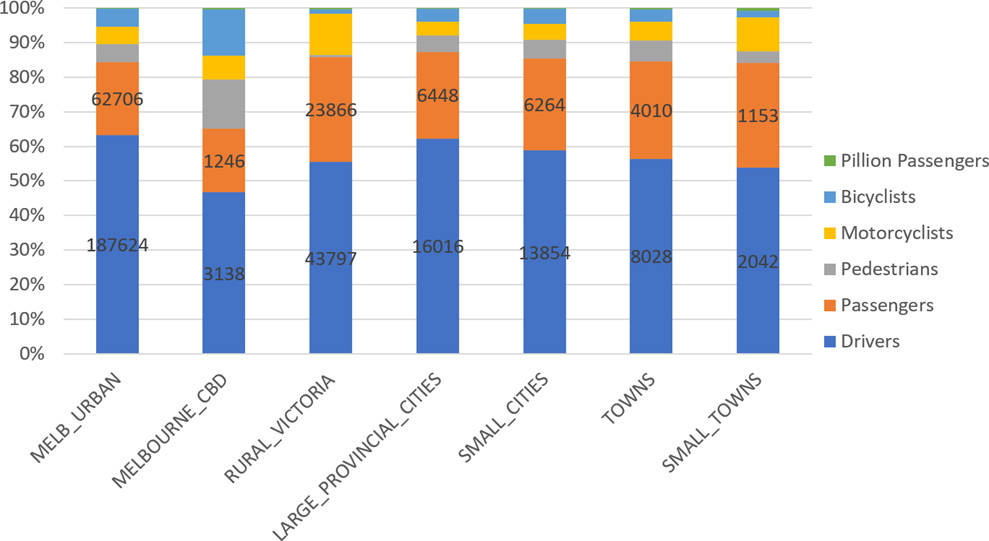Cooperative Intelligent Transport Systems (C-ITS) combine information technology and mobile communication to enable data and command transmissions between vehicles, roadside infrastructure and a central management systems, in order to improve roadway safety for all users, as well as traffic flow efficiency in the network.
The recent technological advancements in vehicle-to-vehicle and vehicle-to-infrastructure communications (vehicle connectivity, in general), wireless sensors, video analytics, artificial intelligence, edge computing and IoT can support and accelerate cooperative transport systems for Australian cities. However, the potential safety and efficiency benefits from connected vehicles are unlikely to be realised in the immediate future in Australia due to the age of our fleet and the limited connectivity of new vehicles.
Increasing the uptake of road safety technology was a key recommendation of the 2018 National Road Safety Strategy Inquiry report, with joint commitment to support the recommendation through the Road Safety Working Group’s Implementation Plan.
There is a strong commitment across all levels of government to improve safety outcomes on our roads. Governments are progressing standards to support the deployment of technology such as Autonomous Emergency Braking, along with broad improvements in crash protection.
There is a potential to increase the number of compatible connected vehicles within the Australian fleet over the next decade through the fitting of after-market devices and/or increasing the demand of consumers for connectivity to be enabled in new vehicles arriving in Australia. An increase in connected vehicles is likely to lead to improved road safety outcomes for the community.
ANCAP Safety modelling on road death projection estimated that with an increasing population and no changes to current road death rates over the next five years, around 6,000 lives will be lost on Australia’s roads.
AAA research found that in 2018–19, congestion costs are expected to exceed $23 billion, which will be more than the value of all road-related expenditure. Without major policy changes, congestion costs are projected to reach between $30.6 and $41.2 billion by 2030.[1].
Safety and congestion are two of the key challenges on our networks and there is strong potential for connectivity and C-ITS to improve these vital problems.
In August 2019 the Transport Infrastructure Council (TIC) endorsed the Land Transport Technology Action Plan 2020-2023 that underpins the National Policy Framework for Land Transport Technology, focusing on the five themes of:
- Safety, Security and Privacy;
- Digital and Physical Infrastructure;
- Data;
- Standards and Interoperability; and
- Disruption and Change.
A new action identified in the Plan is 1.4 – ‘Accelerate and incentivise the uptake of road safety technologies and innovation’.
Connected vehicles can increase safety and network efficiency outcomes. In urban environments increased connectivity of vehicles could enable improved network productivity[2] and offer safety benefits for all road users. In rural and regional contexts, safety and productivity improvements result in social equity and accessibility benefits.
There is a mix of technology and levels of connectivity required and range of use cases to consider for optimal outcomes. An evidence base is needed to better understand the options that can offer the most effective safety and efficiency benefits on Australia roads.
There is a potential to increase the number of compatible connected vehicles within the Australian over the next decade through the fitting of after-market devices and/or increasing the demand of consumers for connectivity to be enabled in new vehicles arriving in Australia. An increase in connected vehicles is likely to lead to improved road safety outcomes for the community.
Project Stages:
- Literature review – national and international analysis of existing research, journal publications, and papers to assess approaches, challenges and opportunities
- Data collection and analysis to model potential pathways
- Assess customer (driver) segments and jurisdiction types (urban / regional) to estimate maximum benefits against minimal expenditure (financial and resources)
- Decision gateway to investigate potential use-cases in sample jurisdictions
Literature Review / Desktop Research:
- National existing research, journal publications, and papers to assess approaches
- International existing research, journal publications, and papers to assess approaches
- Key stakeholder interviews
- Assessment of penetration rates projection from now across pre-determined timeframe
- Technology analysis and benchmarking including devices as well as communications protocols and mix of uses
- Use-cases analysis testing for maximum benefit – safety and network productivity
- Urban
- Regional / Rural
- Corridor
- A report detailing the analysis of the literature review and desktop study of the applications and penetration of levels of connectivity and opportunities for connected and C-ITS enabled vehicles to enable positive impacts in safety and network productivity. Including potential use cases considered based on data analysis, literature review, and stakeholder interviews.
[1]
https://www.aaa.asn.au/wp-content/uploads/2019/06/Road-Congestion-In-Australia-2019-v.3.pdf
[2] Talebpour, A. and Mahmassani, H.S., 2016. Influence of connected and autonomous vehicles on traffic flow stability and throughput. Transportation Research Part C: Emerging Technologies, 71, pp.143-163.


